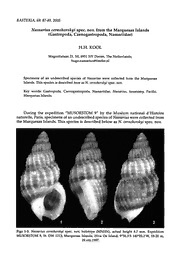
Nassarius cernohorskyi spec. nov. from the Marquesas Islands (Gastropoda, Caenogastropoda, Nassariidae) PDF
Preview Nassarius cernohorskyi spec. nov. from the Marquesas Islands (Gastropoda, Caenogastropoda, Nassariidae)
BASTERIA, 69:87-89, 2005 Nassarius cernohorskyi spec. nov. from theMarquesas Islands (Gastropoda, Caenogastropoda, Nassariidae) H.H.Kool Magnolialaan21, NL6951 NVDieren, TheNetherlands; [email protected] Specimens of an undescribed species of Nassarius were collected from the Marquesas Islands. Thisspeciesis described here asN.cernohorskyi spec.nov. Key words: Gastropoda, Caenogastropoda, Nassariidae, Nassarius, taxonomy, Pacific, MarquesasIslands. During the expedition "MUSORSTOM 9" by the Museum national d'Histoire naturelle,Paris, specimens ofanundescribedspecies ofNassarius were collectedfrom the Marquesas Islands. Thisspecies is describedbelowas N. cernohorskyi spec.nov. Figs 1-3. Nassarius cernohorskyi spec. nov, holotype (MNHN), actual height8.7 mm. Expedition MUSORSTOM 9, St. DW 1213,Marquesas Islands,Hiva OaIsland, 9°50.3’S 140°03.2’W,18-20 m, 29.viii.1997. 88 BASTERIA, Vol. 69, No. 4-6,2005 Abbreviations: HHK, collection H.H. Kool, Dieren, The Netherlands; MNHN, Museum national d'Histoire naturelle, Paris; RMNH, Nationaal Natuurhistorisch Museum, Leiden, The Netherlands; USNM, NationalMuseum of Natural History, Washington DC, USA; ZMA, Zoologisch Museum, University of Amsterdam, The Netherlands. Subfamily NassariinaeIredale, 1916 GenusNassariusDuméril, 1806 Nassarius cernohorskyi spec.nov. (figs 1-3) Material examined (holotypeand paratypes).-The coordinates arepreceededby the station codes.Marquesas Islands,campagne MUSORSTOM9, DW 1213,lie Hiva Oa, 9°50.3'S 140°03.2'W, 18-20m (MNHN holotype/475paratypes;ZMA 4.04.021/5;RMNH/5;USNM/2;O.K.McCausland, Sarasota,Fla.,USA/2;G.Hansen,Lathlain,WestAustralia/2;H. Dekker,Winkel,TheNetherlands/2; HHK 109.01/15);DW 1142,9°21.1'S 140°02.7'W,33-34m (MNHN/2);DW1152,7°58.9'S 140°43.5'W, 85-150m (MNHN/2);DW 1155,7°58.9'S140°43.3'W,80 m (MNHN/1);CP 1156,7°59.0'S 140°43.7'W, 80 m (MNHN/2); DW 1161, 8°55.6'S 140°06.1'W, 30-37 m (MNHN/230); DW 1162, 8.°56.2'S 104°06.1'W,45-64 m (MNHN/35); DW 1184, 8°49.3'S 140°03.6'W, 23-30 m (MNHN/2000+; HHK 109.05/16);DW 1185, 8°48.9'S 140°03.4'W,31-33 m (MNHN/80);DW1186, 8°48.1'S 140°03.5'W,42- 45m (MNHN/32);DR 1197,9°57'S 140°02'W,277-372 m (MNHN/2);DW 1203,9°52.7'S 139°02.2'W, 60-61 m (MNHN/1); DW 1206, 9°51'S 139°09'W, 352-358 m (MNHN/1); DW 1209, 9°50.2'S 139°02.5'W, 85 m (MNHN/39); DW 1210, 9°50.4'S 139°00.5'W, 98-100 m (MNHN/60); DW 1211, 9°50.2'W 139°02.5'W,50 m (MNHN/67; HHK 109.02/5);DW 1214, 9°49.8'S 140°03.1'W, 25-40 m (MNHN/18);CP 1215,9°49.5'S 140°02.0'W,49-62 m(MNHN/9);DW 1217, 9°44.5'S 138°49.9'W,85- 87 m (MNHN/5); DR 1223, 9°44.5'S 138°51.3'W, 90-150 m (MNHN/20); DW 1224, 9°44.6'S 138°51.1'W,115-120 m (MNHN/15);DW 1225, 9°45.2'S 138°52.6'W,42-70 m (MNHN/100); CP 1228, 9°44.8'S138°51.5'W, 107-108 m(MNHN/3);DW 1235,9°42.0'S 139°03.0'W,105-285 m (MNHN/1);CP 1239,9°42'S 139°03.6'W,89-95m(MNHN/1);DW 1241,10°27.8'S 138°40.6'W,85-130m (MNHN/8); DR 1244, 10°28'S 138°42.1'W, 1015-1020 m (MNHN/4); DR 1245, 10°29.0'S 138°26.2'W,85-130 m (MNHN/3);DW 1260, 9°25.4'S 140°07.3'W,49-100 m (MNHN/1);DW 1279,7°59.4'S 140°42.2'W,23- 70m(MNHN/1);DW 1280,7°58.9'S 140°43.3'W,87-98m(MNHN/3);DW 1283,7°53.8'S140°34.5'W, 55-56 m (MNHN/1); DR 1292, 8°54.1'S 139°37.8'W, 95-100 m (MNHN/40); DR 1293, 8°54.3'S 139°37.5'W,50m(MNHN/33);DR 1297,8°54.2'S 139°37.4'W,90-150m (MNHN/7);DR 1298, 8°49.0'S 140°17.0'W, 305 m (MNHN/10); CP 1304, 8°54.4'S 140°13.9'W, 50-58 m (MNHN/16); DR 1305, 8°54.1'S140°14.5'W,90-155 m (MNHN/58);St.22,Ua Huka, Baiede Vaipee,6-10 m (MNHN/2);St. 23, 8°55.9'S 139°31.5'W (MNHN/3); St. 24, 8°53.6'S 139°37.0'W, 9-15 m (MNHN/210; HHK 109.04/10); St. 24 bis, Ua Huka, 8°53.6'S 139°37.0'W, 20-34 m (MNHN/560; ZMA 04.05.020/5; RMNH/5; H. Dekker, Winkel/2; HHK 109.03/15);St. 30,Ua Huka, 8°56.1'S 139°32.0'W,20-30 m (MNHN/11);St.34, UaHuka, 8°56.8'S 139°35.7"W,10-15m (MNHN). Description of holotype.— Shellheight 8.7 mm,width4.3mm. Protoconchtrans- parent, with 33A whorls, last two whorls strongly keeled. Teleoconchof 41/2 convex whorls.Shellshiny, quite thin,semi-transparent. Last whorlwithabout16 thin, axial ribs, crossed by about 11 thin, over-riding spiral threads, forming low, glossy beads atthe crossings, strongest atthe suture, also onthe earlier whorls.Penultimatewhorl with15axial and6-7 spiral ribs. The interspaces of the axial ribs variable;the whole Kool:Nassarius cernohorskyi spec. Nov. 89 shellwith clear growth lines (under magnification). Varixof the outerlipbroadbut thin, with the spiral ribs of the body whorl visible. Aperture ovate, with thinouter lip;aboutnine faintliraewithin; columellaandparietal wall coatedwithawell-bor- deredenamel-likecallus, showing some very faintlirae; parietal denticleweak.Anal andsiphonal canal wide. Siphonal area with afaintfasciole andabout 7 spirals and microscopic axial striae. Basic colourwhitish to yellowish, protoconch lightbrown- ish.A (sub)sutural brownband on all teleoconchwhorls, two morebrownbands on the body whorl, one on and betweenthe two spiral threads at the periphery and a wider one at the base. Aperture reflecting the outside colour and banding; varix, outerlip andsiphonal area white. Operculum yellowish, ovaland non-serrated. Habitat.— The depth at which the specimens were obtained is very variable. Specimens were collected at9,butalso at 358m. Most deadspecimens with anoper- culumwere dredged at9-34 m in finemuddy sand. Etymology.— Thenewspecies is namedafterW.O.Cernohorsky, in honourofhis pioneering work onthe family Nassariidae, resultingin booksand paperswhich are invaluablefor furtherstudieson this family. Variability.— The species is very variablein many features. Mature specimens measure4.5-11.7mm. The numberofribs onthebody whorlof thelargest specimens varies fromabout 15to 22.The numberof postnuclear whorls variesfrom3 to 4.5. The holotype hasabout 15axial ribs onthe first postnuclear whorl, but somesmall mature specimens haveonly 8 to9 ribs, which are stronger. Thisdifferencein num- ber of ribs is also perceptible on the succeeding whorls. The aperture of the small specimens differsin thattheliraeonthe insideofthe outer lip are more distinct.The width and the intensity of the colouredbanding are also somewhat variable.The semi-transparency and the microscopic, butwellvisible, growth linesare character- istic for thisspecies. Although the shell is thin and transparent, itis not fragile. Distribution.— Although the species is abundantat some localities, its distribu- tion seems tobe very limited.To dateit is only knownfromthe Marquesas Islands. Discussion.— Nassarius cernohorskyi spec. nov. is somewhat similar to N. sub- translucidus (E.A. Smith, 1903), a species without the spiral sculpture all over the bodywhorl, whichis shoulderedmoreconspicuously, and lesstransparent.Theholo- typeof N.subtranslucidusis figured by Cernohorsky (1984: pi. 30fig. 8) andKaicher (card 4098). ACKNOWLEDGEMENTS Thanks are due to Dr P. Bouchet (MNHN), who enabledthe author to study a part of the nassariid species, collected during several expeditions; also to R. Moolenbeek(ZMA) forhis general supportandMrs Virginie Heros(MNHN)forper- fect communication.The photographs are by Mrs Delphine Brabant (MNHN), H. Dekker madethe composition for this publication. REFERENCES CERNOHORSKY, W.O., 1984. Systematics of the family Nassariidae Mollusca: Gastropoda. — Bulletin ofthe Auckland Institute and Museum 14:i-iv, 1-356. KAICHER, S.D., 1985.Card catalogueofworld-wide shells. Pack No. 41Nassariidae partIII,cards 4044-4199.
